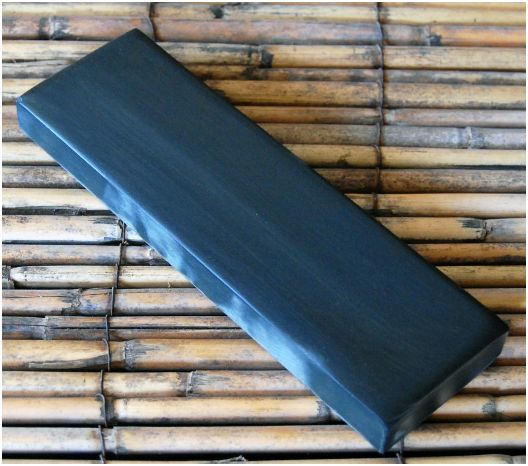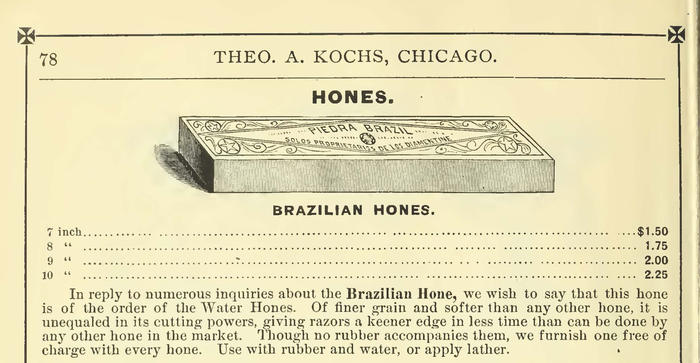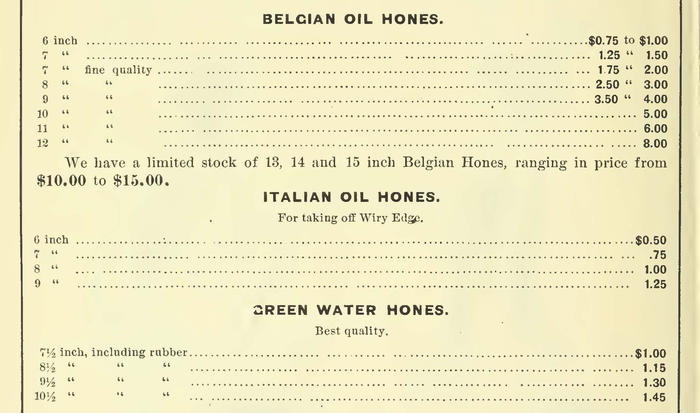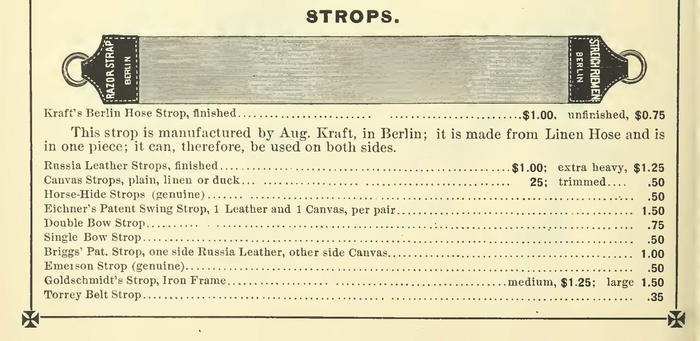Results 1 to 10 of 22
-
04-01-2014, 08:48 AM #1
 Old Brazilian Water Hones "Piedra Brazil" (Schist)
Old Brazilian Water Hones "Piedra Brazil" (Schist)
Found an old catalogue from 1888 were the Brazilian Hones are marketed directly on the oposite site of the German Water Hones (Escher). Interesting ist that these stones were sold in higher prices to this time then the German ones (7inch, 1,50 USD, German one 1,25 USD)...
Also it seems like that the company did a cooperation to with the supllier / the quarry owner as beeing the one and only seller....
My question is just in this thinking if anybody has a proper sample of a kind of "old Brazilian" Water Hone, because it seems
to be that these stones were great performers....


Some Customer Statements from 1888:


Last edited by doorsch; 04-01-2014 at 10:08 AM.
███▓▒░░.RAZORLOVESTONES.░░▒▓███
-
-
04-01-2014, 10:18 AM #2Senior Member

- Join Date
- Feb 2014
- Location
- Eindhoven, The Netherlands
- Posts
- 235
Thanked: 24
it seems like HAD isn't bound to our current time if I read that customer statement correctly... I hope one turns up in this thread

-
04-01-2014, 10:38 AM #3Senior Member



- Join Date
- Apr 2008
- Location
- Essex, UK
- Posts
- 3,816
Thanked: 3164
There are a couple of youtube videos (well - more than a couple, but one or two are of especial interest to us) by PeriodWoodworker online.
In one, maybe two, he shows a number of examples of Brazilian Hones that he has come across. Although he has numerous examples, they seem to be limited to two manufacturers, the Clauss Shear Co. in Fremont and Bracketts Compound Brazilian Hone in Michigan.
The former is 7" x 2" and the latter 5" x 2". Both appear to be man made.
He reads that the Clauss Hone is made from especial brazilian pebbles (which appear to be some sort of quartz) and says that they are sintered and ground with something else to form them into shape. In the examples with original rubbers, the rubber appears to be a bit of compound BBW/Coticule. One works up a slurry on the surface of the hone - which he says resembles a very fine dark arkansaw hone. He says the there are various colours, yellowish, chocolate-brownish, etc. Some appear to be translucent.
I expect the colour variation is in part due to the natural stone, and in part due to the filler. To the filler one can perhaps add another abrasive, as the Brackett Combination Brazilian Hone seems to offer two degrees of abrasion. I suppose this could also be achieved by more filler-to-natural on one side, making that side cut slower.
I have no doubt that other sorts of 'Brazilian' hone existed - it was quite an innovative place at one time for all sorts of silvers and iron alloys as well as, like other parts of South Amerca, possessing a very high degree of wealthy german immigrants - and that the hone shown by Doorsch owes more to water stones than to a seemingly adamantine oil-type hone. In fact, the advertisement he shows has them likened to thuringians, so one would suppose that they where a slate-honing stone rather than the Clauss and Bracketts quarz-type stone, which seems more novaculite in nature.
The trouble with 'trade names' is that is all they are - they need not have any veracity of place of origin behind them at all, and one wonders whether the thuringian-type Brazilian hone really came from Brazil at all.
Regards,
NeilLast edited by Neil Miller; 04-01-2014 at 10:43 AM.
-
The Following User Says Thank You to Neil Miller For This Useful Post:
Margeja (04-01-2014)
-
04-01-2014, 11:01 AM #4

Thanks Neil for your explanation on this Issue and the Information on the vid... i already had known the Periodwoodworker Videos but not that Video on the Brazilian Hones....and yes Neil for shure we do not know if these ones was really quarried in Brazil.....
I would firstly like to see one, then i would appreciate if the one who ones it can share his experiences, and then i want some more HAD :-) Just joking, it would be great to see if there is any old one of these "alive"....in thinking how old these ones are and up to date knowing that these were probably only sold by this catalog company i would think these are quite rare and harder to find then any Escher or other comparable labelled hone (f.ex. the Magog Oilstone)it seems like HAD isn't bound to our current time if I read that customer statement correctly... I hope one turns up in this thread
-
04-01-2014, 03:33 PM #5Historically Inquisitive



- Join Date
- Aug 2011
- Location
- Upstate New York
- Posts
- 5,782
- Blog Entries
- 1
Thanked: 4249
Looking at the label of the Brazilian hone, it seems to me that this is a natural stone from Brazil as you can see on the label "Sole Proprietor de la Diamanta quarries".
Tc blade has a Brazilian Black slate on his webpage.

-
01-24-2017, 01:40 AM #6

Bringing this old thread back to life to share a page of a Theo A. Kochs catalogue from 1884 advertising the Brazilian hone among others. Zooming in on the picture the hone says "Piedra Brazil solos proprietarios de los Diamentine" and the ad "...we wish to say that this hone is of the order of the Water Hone. Of finer grain and softer than any other hone, it is unequaled in its cutting powers giving razors a keener edge in less time than can be done by any other hone on the market."
These ranged from $1.50 - $2.25, again more expensive than the Green Water Hones which ranged from $1.00 - $1.45.
But it's the Belgian hones that got "pricey" going all the way up to $15 for a 15 inch piece. Also mentioned are Italian oil hones (?) "for taking off wiry edge", and strops made from linen hose and various leathers.



Last edited by xiaotuzi; 01-24-2017 at 12:47 PM. Reason: spelling
"Go easy"
-
-
01-24-2017, 06:09 AM #7illegitimum non carborundum



- Join Date
- Jan 2008
- Location
- Rochester, MN
- Posts
- 11,552
- Blog Entries
- 1
Thanked: 3795
Great.
Now I want a Brazilian hone.
-
01-24-2017, 06:21 AM #8
-
01-24-2017, 06:22 AM #9
-
01-24-2017, 08:22 PM #10< Banned User >

- Join Date
- Oct 2016
- Location
- Saratoga, CA
- Posts
- 597
Thanked: 59
Well I just bought the only one on ebay that purported to be a Brazilian hone. We'll shall see.... This particular seller has had some of the most interesting stones come up for sale. I ended up passing on it, afraid it might show up as a cnat...
Last edited by Aerdvaark; 01-24-2017 at 10:21 PM.


 41Likes
41Likes LinkBack URL
LinkBack URL About LinkBacks
About LinkBacks






 Reply With Quote
Reply With Quote

